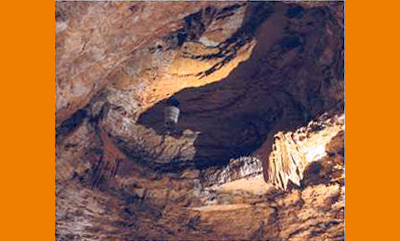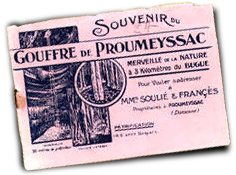

| Previous page | page 5-5 |
Visitors would arrive inside the cave halfway up one of the walls, on a 23-tonne platform designed by Bordeaux architect Raoul Jourde, who also designed the Bordeaux stadium, and the engineer Massé. From there, visitors would be able to enjoy an exceptional overall view. Since the cave opening is far enough away from the road, it would be easy to reach the surface with a relatively low slope.
While the digging of 70-metre trench, in the open air, by a local company, posed no problem, the same did not apply to the actual tunnel that was to follow: digging 112 metres into the rock. A mine specialist had to be brought in from Sweden and he, along with the company Labaudinière de Brive (Corrèze), worked hard at the delicate task of not breaking any of the concretions.

For the portion closest to the cave, a quarry master from Paussac, Mr. Large, drilled about ten metres from the edge of the cave using hand tools. The two sections connected perfectly. The final stroke of the pickaxe was "official" and the champagne served on the platform of a van set up in this vast wooded car park commemorated the event in the presence of friends and celebrities of the department. It was 28 February 1957. Construction was not yet finished. There was work to be completed, lighting to installed, and outdoor areas to be cleaned....
In short, it wasn't until Pentecost 1957 that guides in full uniform, wearing a braid-trimmed cap with the initials "G.P." (including Roger Francès and Fernand Soulié, the sons of inventors, Eyrignoux and Mérillou), could take care of the many visitors who flocked to admire " the cathedral of crystal." Proumeyssac had resumed its former full activity.
The ill Marcel Maufrangeas was not able to enjoy the renovated cave for very long. He left this world, leaving the position of director to Georges Laville, a shopkeeper from Le Bugue who was well-liked for his energy, hard work and creative spirit. At the same time, he took over as head of the Tourist Information Office. Of course, since 1957, there have been visits after visits and the petrifying fountain continues to cover entrusted objects with shiny flecks of calcite. Of course, we could stop there... But the demon of adventure, the lure of the unknown and the desire to do better, remained. If we stopped there, it would be not to take into account the affection Georges Laville had for this cave and his ideas of searches and improvements....
But let's go back a bit!
In 1907 already, E.-A. Martel had imagined the existence of a deeper hidden network: "Currently, the stream which built but did not finish it, is either dried up, or significantly reduced, in any case deeply buried under the debris cone. Its existence is proven by two facts:
1 - There is a small spring to the west, in Perdigat on the left bank of the Vézère, at a level which is lower than that of the cave (I did not have the time to go and see it).
2 - Several of the stalagmite columns around the debris cone are broken in the half; we know that this phenomenon, which is frequent in caves, is evidence of underground subsidence which is generally the result of running waters (whether they are known or not) that continue sapping. As for finding the stream, as Mr Galou hopes, it seems very random and subject to pure chance; we do not know the thickness of the debris cone; it could measure several decametres. And the calcite which is so hard to puncture, has completely walled up the lower circumference of the cave; in vain, we have already broken this obturating surface in some spots. Its plus has not delivered a sufficient continuity solution to continue the exploration. There is no indication of where there is a greater likelihood of reaching an accessible gallery. I would add that, in all likelihood, it is only in one direction, being (entirely unknown) the one upstream from the current, where a wide corridor may exist."
Then, in the 50s, Norbert Casteret made the following declaration to journalists:
"The existence of a lake is possible but I cannot say for sure. Only extensive searches could provide results". And in 1956 the press even revealed that: "Boring was carried out thanks to the existence of a fracture. 33 metres down, we did not find the bottom; there is therefore another, probably more vast, Proumeyssac that exists underneath Proumeyssac.
In 1973, Georges Laville decided to start with what seems to be the beginning: evacuating the mass of fallen rocks! This helped restore the cave to its natural aspect, and beyond that - perhaps new galleries could be discovered.
It was no easy task! But he did not let it scare him and backed by his friend and director, R. Laval, he tackled the project. After many ups and downs, a large crane made its appearance in the area around the natural opening of the cave, plunged its monstrous jaw in the hole and extracted its first heap of rubble
Thus, during 1974-1975, the cave was cleared of much of its enormous debris cone.
The tonnes of loose stones that were thrown in long ago, and the products of "natural landslides" were brought to the surface and evacuated: 400 m3 of rubble were thus uncovered or brought back to the surface.
Careful examination of the tonnes of debris led to the discovery of animal bones, more or less ancient tools, as well as human bones (including a piece of skull ) that could confirm the words of the good people of the Middle Ages. Even more ancient, a box of bronze coins, called "blancs" or "douzains" bearing the coat of arms of King Francis 1, was removed from the debris. All of these treasures can be seen in the museum of the site.
 Since then, during the transitional period between 1980-1990, under the leadership of Mrs Duret who took over for her father Mr. Laville, the cave was equipped with new high-performance lighting and a sound system, both computer-controlled, reception buildings which included a museum, book shop, bar, souvenir shops and exhibition rooms. 1990-1998: Mrs Duret and Alain Francès continued to dedicate all theirs efforts to improving and running the cave. Thanks to their collaboration, tour surveillance by means of cameras and televisions was implemented, the size of the platform was increased by a good third, and tour guides were equipped with wireless microphones.
Since then, during the transitional period between 1980-1990, under the leadership of Mrs Duret who took over for her father Mr. Laville, the cave was equipped with new high-performance lighting and a sound system, both computer-controlled, reception buildings which included a museum, book shop, bar, souvenir shops and exhibition rooms. 1990-1998: Mrs Duret and Alain Francès continued to dedicate all theirs efforts to improving and running the cave. Thanks to their collaboration, tour surveillance by means of cameras and televisions was implemented, the size of the platform was increased by a good third, and tour guides were equipped with wireless microphones.
The owners were still the Francès and Soulié families: the grandsons and great grandsons of the "adventurers" of 1907.
Attempts, which for the time being (but only for the time being!) have been unsuccessful, have still not allowed us to reach the active network that likely exists under the debris at the bottom of the chasm and continues to fire the imagination of tourists and cavers.
| Previous page | page 5-5 | |